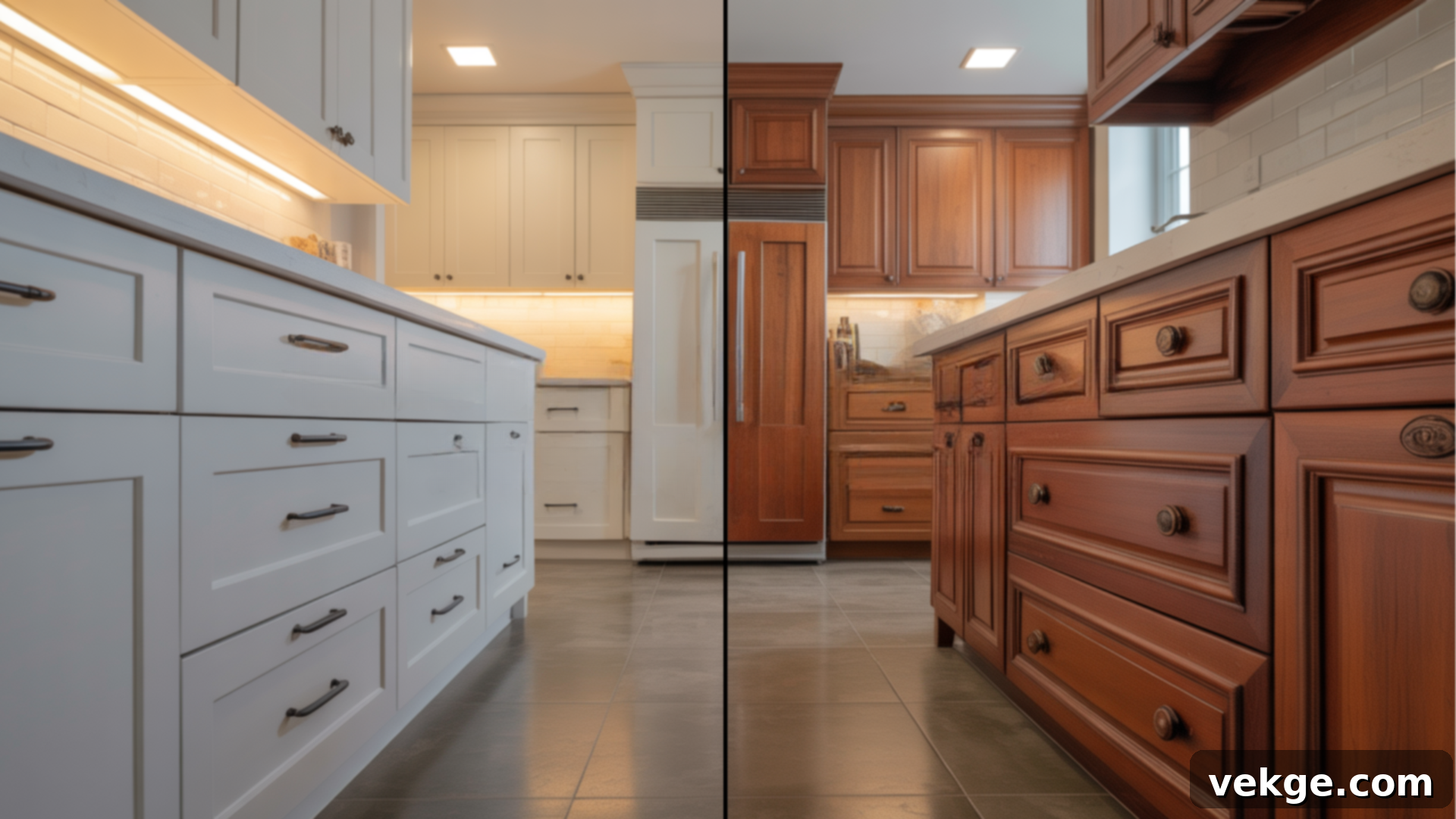Shaker vs. Traditional Cabinets: The Ultimate Guide to Choosing Your Perfect Kitchen Style
Embarking on a kitchen remodel often brings a wealth of exciting, yet sometimes daunting, decisions. Among the most pivotal choices homeowners face is selecting the right cabinet style. Have you ever found yourself torn between the clean simplicity of Shaker cabinets and the rich, ornate detail of traditional ones? You’re certainly not alone; this is one of the most common dilemmas during a kitchen transformation, as cabinets define the entire aesthetic and functionality of your space.
I understand how overwhelming it can feel when every choice, from the smallest knob to the largest appliance, impacts both the look and daily functionality of your home. It’s a significant investment, and you want to ensure the final result perfectly reflects your taste and serves your needs for years to come.
In this comprehensive guide, we’ll help you navigate this important decision by comparing these two iconic cabinet styles side by side. We’ll delve into everything from their distinctive design features and common materials to their maintenance requirements, cost implications, and how they suit various kitchen layouts. By the end, you’ll possess a clearer understanding and feel more confident about choosing the cabinet style that truly works best for you and your beloved home.
Overview of Shaker and Traditional Kitchen Cabinets
Before diving into the intricate details, let’s establish a foundational understanding of what defines Shaker and Traditional kitchen cabinets. Both styles boast enduring popularity and have earned their classic status, yet they appeal to vastly different aesthetic sensibilities. Understanding their core distinctions is the first step toward making an informed decision for your kitchen design.
Signature Design Features: Simplicity vs. Sophistication
Shaker cabinets are celebrated for their understated elegance and timeless appeal. Their design is rooted in the 18th-century Shaker religious movement, which emphasized honesty, utility, and modesty. This philosophy translates directly into their construction: a five-piece door with a flat, recessed center panel framed by four flat rails and stiles. The lines are clean, the surfaces are flat, and ornamentation is conspicuously absent. This minimalistic approach gives them incredible versatility, allowing them to seamlessly blend with a wide range of kitchen styles, from contemporary and transitional to farmhouse and even industrial designs.
In stark contrast, Traditional cabinets embrace elaborate detail and rich ornamentation. Their craftsmanship often reflects old-world elegance, drawing inspiration from European, Victorian, or Colonial design influences. Key features include raised center panels, intricate carvings, decorative trim, crown moldings, corbels, and glazed or distressed finishes. These elements collectively create a sense of grandeur and formality, making traditional cabinets a perfect fit for kitchens aiming for a luxurious, stately, or historically-inspired aesthetic.
Common Materials and Finishes: Natural Beauty in Different Forms
Both Shaker and Traditional cabinet styles frequently utilize durable hardwoods, a testament to their lasting quality. Common choices include maple, cherry, oak, or walnut, each offering unique grain patterns and characteristics. However, the application of finishes diverges significantly, reflecting their distinct design philosophies.
Shaker cabinets typically feature painted finishes, with white, gray, and natural wood tones being perennial favorites. These lighter, simpler finishes highlight the clean lines and reinforce the style’s commitment to an uncluttered look. The absence of intricate details means the paint or stain can be applied smoothly and evenly, contributing to their sleek appearance.
Traditional cabinets, on the other hand, often showcase darker stains, glazed finishes, or distressed treatments. These techniques are deliberately chosen to enhance and highlight the intricate carvings, raised panels, and decorative moldings, creating a rich, formal, and sometimes antique-like appearance. The depth and warmth of these finishes contribute significantly to the luxurious feel inherent in traditional designs.
Pros and Cons of Shaker & Traditional Cabinets: A Quick Glance
Each cabinet style brings its unique set of strengths and limitations to the table, impacting everything from overall aesthetic to long-term upkeep and budget considerations. Here’s a quick summary to help you weigh your options:
|
Style |
Pros |
Cons |
|
Shaker Cabinets |
Classic and timeless look, incredibly versatile, generally easier to clean, budget-friendly options widely available, high adaptability for various kitchen designs. |
Can sometimes appear too plain for those desiring more detail, recessed edges can accumulate dust and grime if not regularly wiped. |
|
Traditional Cabinets |
Offers a luxurious and sophisticated appearance, showcases detailed craftsmanship, perfectly suits classic, elegant, and historically-inspired interiors, provides a sense of grandeur. |
Typically more expensive due to intricate details and labor, harder and more time-consuming to clean because of moldings and carvings, may not suit modern or minimalist spaces, can potentially feel dated over time. |
Shaker Vs. Traditional Cabinets: Key Differences Unpacked
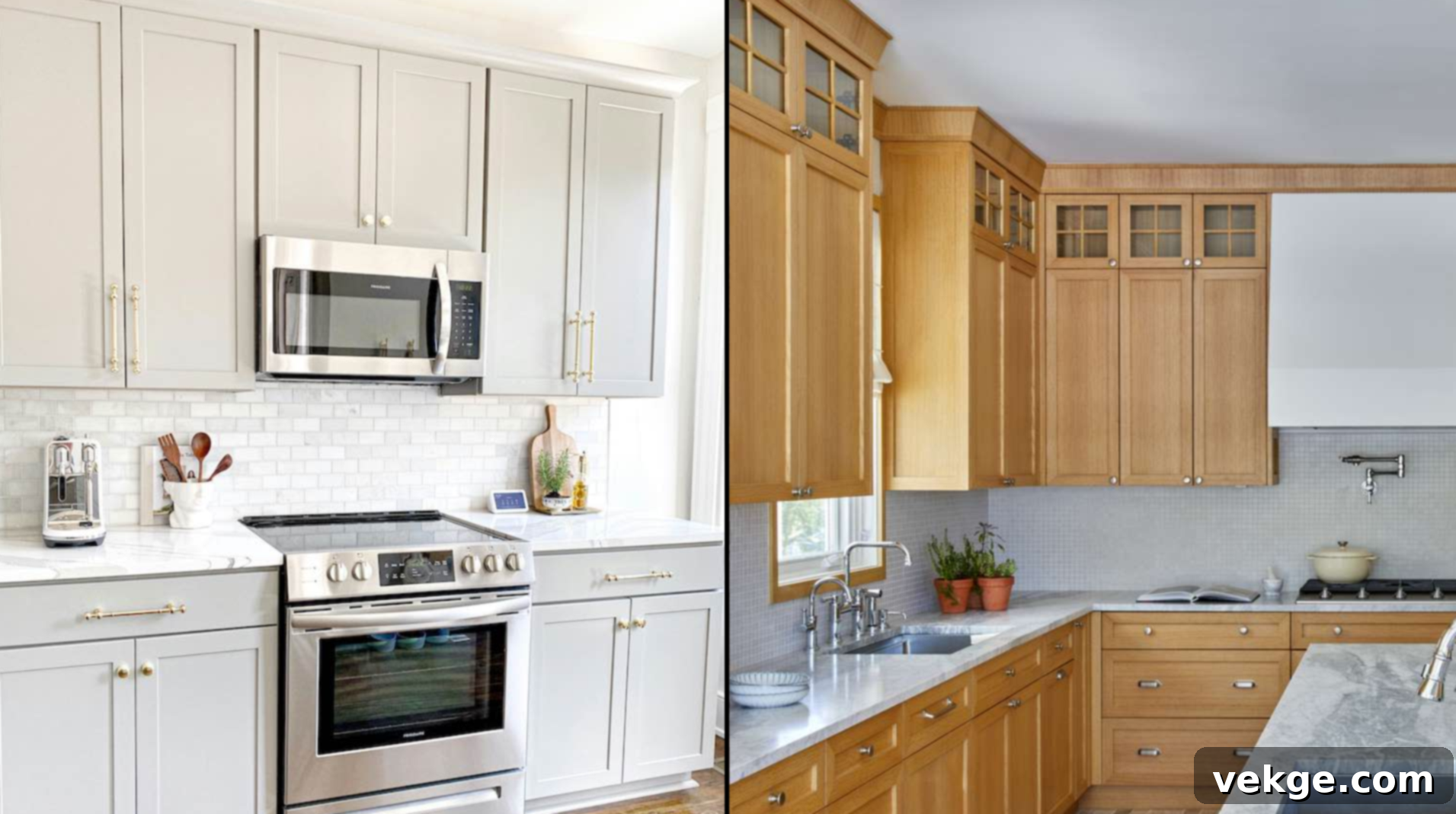
Beyond their foundational design principles, Shaker and Traditional cabinets diverge significantly in practical aspects like cost, maintenance, and how well they integrate with various kitchen layouts and overarching home themes. Let’s explore these crucial distinctions in more detail.
Cost Comparison: Understanding Your Investment
The financial aspect is often a primary concern for homeowners. Shaker cabinets generally present a more budget-friendly option. Their simpler construction, fewer custom details, and straightforward finishing processes translate to lower manufacturing and labor costs. This makes them an excellent choice for homeowners seeking quality and style without breaking the bank, particularly in larger kitchens where the cost per cabinet can add up quickly. While custom Shaker options exist, the inherent simplicity of the design means you often get more value for money.
In contrast, Traditional cabinets almost always come with a higher price tag. This premium is primarily attributed to the increased labor involved in carving intricate details, applying decorative trims and moldings, and often, the need for specialized custom work. The type of wood used, the complexity of the finish (e.g., glazing, distressing), and the addition of custom hardware can further elevate the overall cost. Homeowners considering traditional styles should account for these factors and view it as an investment in highly detailed craftsmanship and a unique aesthetic. It’s important to consider long-term value and how the cabinets align with your home’s overall design, not just the upfront pricing, when making this significant decision.
Cleaning & Maintenance: Daily Upkeep Considerations
When it comes to daily life in the kitchen, ease of cleaning and maintenance can be a significant factor. Shaker cabinets are notably easier to wipe down and keep clean. Their flat surfaces and limited grooves mean less opportunity for dust, grease, and food splatters to accumulate. A quick wipe with a damp cloth is often all that’s needed, making them ideal for busy households or those who prioritize low-maintenance options. However, it’s worth noting that the inside corners of the recessed panels can sometimes collect dust or grime, requiring a slightly more targeted cleaning with a soft brush or cloth.
Traditional cabinets, with their elaborate moldings, raised panels, and decorative trims, require more detailed and time-consuming cleaning. These intricate surfaces are prone to collecting dust, grease, and moisture, particularly in high-traffic cooking areas. Regular, meticulous upkeep is essential to prevent grime buildup and to maintain their luxurious appearance. Specialized cleaning tools, like soft brushes or cotton swabs, might be necessary to reach all the nooks and crannies. While more demanding, consistent care ensures these beautiful cabinets retain their intricate charm over time.
Suitability by Kitchen Design: Matching Style to Space
The architectural style of your home and the desired ambiance of your kitchen should heavily influence your cabinet choice. Shaker cabinets, with their clean lines and understated presence, blend exceptionally well in open-concept floor plans and homes featuring clean, contemporary layouts. They pair beautifully with natural light, light-colored walls, minimalist decor, and modern appliances. Their adaptability means they can be dressed up or down with hardware and accessories to fit anything from sleek urban apartments to cozy farmhouse kitchens.
Conversely, Traditional cabinets truly shine in kitchens with rich color palettes, detailed wood flooring, and architectural elements like coffered ceilings, crown molding, or wainscoting. They seamlessly integrate into homes that follow formal design schemes, historic layouts, or those aspiring to a European or classic country aesthetic. When choosing between them, consider how the cabinet style will interact with existing surrounding elements like the natural light, wall treatments, flooring materials, and nearby furniture to ensure a cohesive and harmonious space.
Are Shaker Cabinets Still a Popular Choice Today?
Despite the cyclical nature of design trends, Shaker cabinets have not only maintained their popularity but continue to evolve, solidifying their status as a perennial favorite. They remain a top choice for homeowners and designers alike, primarily due to their unparalleled versatility and timeless appeal. Many contemporary designs now feature slimmer frame versions, known as “slim shaker” or “skinny shaker” styles. These variations offer narrower stiles and rails, providing an even cleaner, more refined, and space-friendly appearance without losing the familiar and beloved five-piece structure. This subtle modification makes them feel more modern and allows them to integrate perfectly into minimalist or ultra-contemporary settings.
Beyond the slimline evolution, classic Shaker designs still strongly appeal to those who prefer a more traditional or transitional setting. Designers widely note a growing interest in soft matte finishes, particularly shades of white, gray, beige, and even muted blues or greens. These finishes enhance the simplicity of the Shaker profile, contributing to a calm and sophisticated atmosphere. The style’s remarkable ability to fit into virtually any kitchen layout and complement diverse decor elements ensures its continued widespread use and enduring popularity among both design professionals and homeowners seeking a cabinet style that will stand the test of time.
Can You Mix Shaker and Traditional Styles in One Kitchen?
Absolutely! Combining Shaker and Traditional cabinets is not only possible but can also be an incredibly effective way to create a kitchen that feels both uniquely personal and harmoniously balanced. This design strategy works exceptionally well in transitional kitchens, which inherently bridge classic elegance with contemporary simplicity.
One popular approach involves using Shaker fronts for lower cabinets, providing a clean, grounded foundation that is also easy to maintain. Then, for upper cabinets, a central island, or a statement hutch, incorporate elements of traditional style. This could mean opting for cabinets with raised panels, decorative moldings, or even incorporating traditional turned legs on an island. This mix adds texture, visual interest, and a touch of bespoke craftsmanship without overwhelming the space.
Another effective method is to utilize Shaker cabinetry throughout the majority of the kitchen while introducing a single traditional-style focal point, such as an ornate range hood or a beautifully detailed built-in hutch or pantry. This allows the clean lines of the Shaker cabinets to dominate, with the traditional element serving as an elegant accent.
To ensure a cohesive look when mixing styles, consistency is key. Choosing consistent finishes – perhaps the same paint color or a complementary stain – across both styles will help tie them together. Coordinating hardware, even if the styles are different, also plays a crucial role in creating a unified aesthetic. By thoughtfully blending these elements, you can achieve a sophisticated and custom kitchen design that avoids feeling mismatched or uneven, offering the best of both worlds.
Choosing the Right Cabinet Style for Your Home: A Personalized Decision
The ideal cabinet style for your kitchen ultimately depends on a confluence of factors: your personal visual preferences, the existing architectural style of your home, your practical lifestyle needs, your budget, and the amount of upkeep you are willing to commit to. Making this choice thoughtfully ensures lasting satisfaction.
Personal Preference & Home Architecture
Your cabinet style should not only reflect your individual design taste but also complement the inherent structure and character of your home. Shaker cabinets naturally suit open-plan living spaces, homes that benefit from abundant natural light, and interiors with modern, minimalist, or transitional aesthetics. They reinforce a sense of openness and simplicity.
Traditional cabinets, conversely, harmonise beautifully with homes featuring formal dining rooms, rich wood trim, more segmented layouts, or historical architectural details. They enhance a sense of established elegance and intricate craftsmanship. When making your decision, thoroughly consider the fixed elements in your kitchen – such as ceiling height, window placement, existing floor materials, and the style of adjacent rooms. Matching your cabinet style with these elements helps the entire space feel thoughtfully integrated and intentional, rather than disjointed or out of place.
Budget & Maintenance Needs
Practical considerations like budget and maintenance are paramount. Shaker cabinets are often more budget-friendly due to their straightforward design and less complex manufacturing process, making them accessible to a wider range of budgets. Furthermore, their simple profiles are significantly easier to clean and maintain, a huge advantage for busy households or those seeking a low-fuss kitchen. A quick wipe-down is usually sufficient to keep them looking pristine.
Traditional cabinets typically demand a higher investment, both initially and in terms of ongoing care. The detailed carvings, moldings, and often custom finishes contribute to higher production costs. These intricate surfaces also require more diligent and frequent cleaning to prevent dust and grime from settling in the crevices. If you’re working within a strict budget or prefer a truly low-maintenance kitchen, Shaker may be the more practical and stress-free option. However, for those who prioritize visual richness, intricate detail, and don’t mind the extra commitment to upkeep, traditional styles offer unparalleled long-term appeal and a luxurious feel, especially fitting for larger kitchens in more formal settings.
Side-by-Side Visual Ideas: Shaker vs. Traditional Cabinets
To help you better visualize the differences and imagine these styles in your own home, let’s explore some side-by-side comparison ideas. These scenarios visually highlight key distinctions between Shaker and Traditional cabinets across various aspects of kitchen design, from layout and detail to material and finish choices. Although we cannot provide actual images here, the descriptions will guide your imagination.
1. Complete Kitchen Layout: Shaker vs Traditional
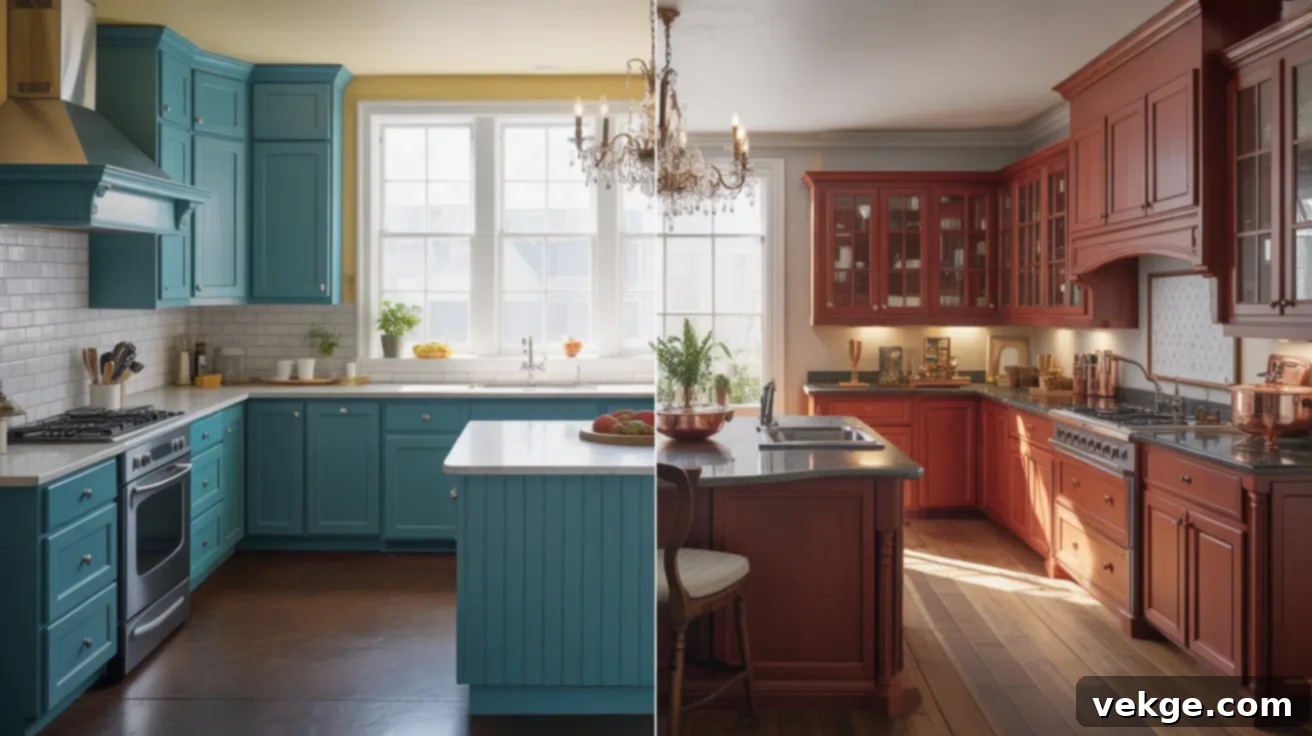
Imagine two complete kitchen settings side-by-side. One showcases a bright, open Shaker-style kitchen, perhaps in white or light grey, with minimalist decor and sleek countertops, conveying an airy, modern feel. The other displays a traditional kitchen featuring rich, dark wood tones, ornate crown molding, and perhaps a classic patterned backsplash, evoking a sense of historical grandeur and warmth. This immediate visual contrast helps readers grasp how each style dramatically changes the overall space and atmosphere.
2. Cabinet Door Close-Up: Flat vs Raised Panel
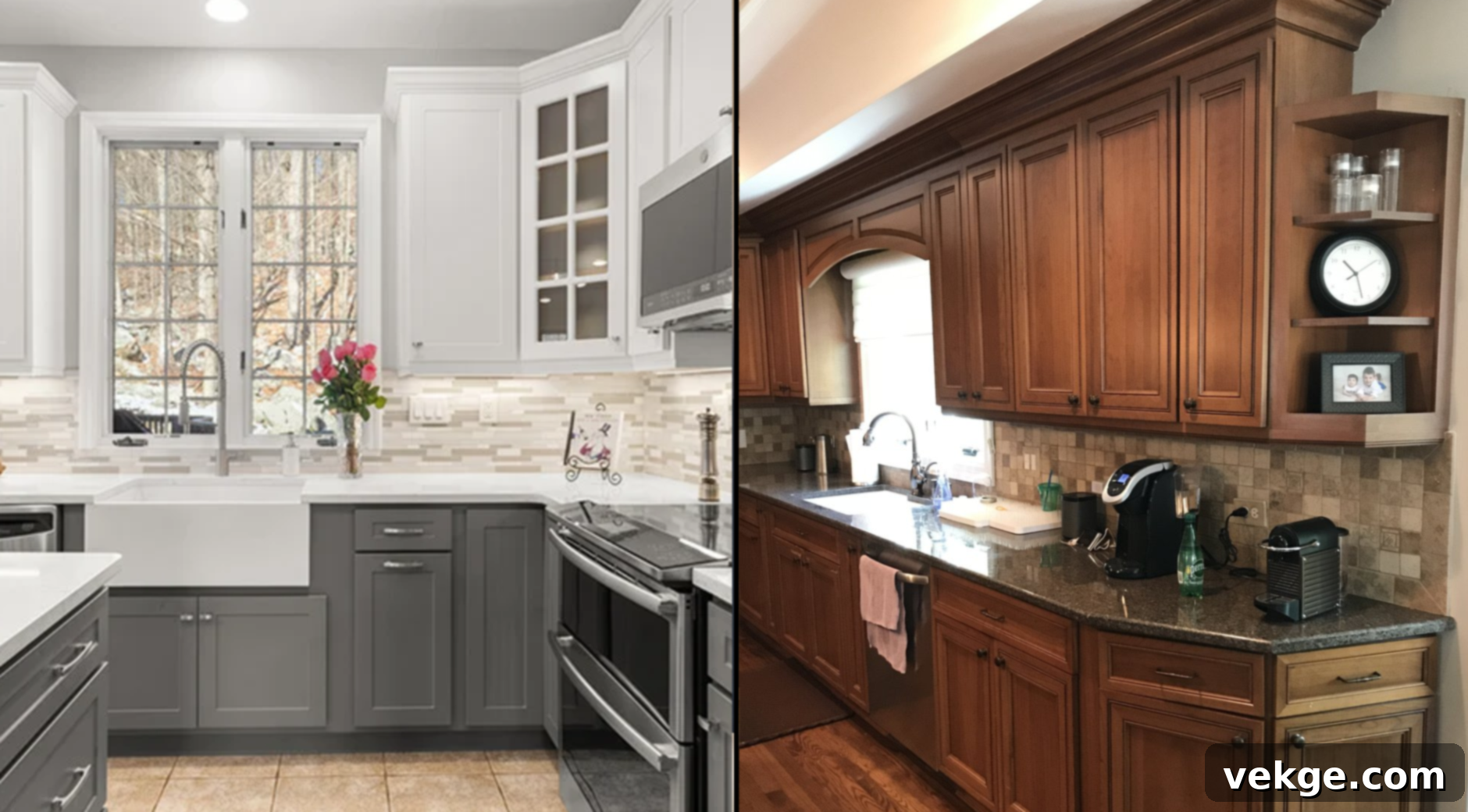
Picture two zoomed-in shots of individual cabinet doors. On one side, observe the crisp, flat, and recessed center panel of a Shaker door, emphasizing its clean lines and simple frame. On the other, study the raised, contoured design of a traditional cabinet door, highlighting its sculpted edges and three-dimensional depth. This close-up comparison makes it easy to discern the fundamental structural and aesthetic differences at the core of each style.
3. Hardware Choices: Modern vs Vintage Accents
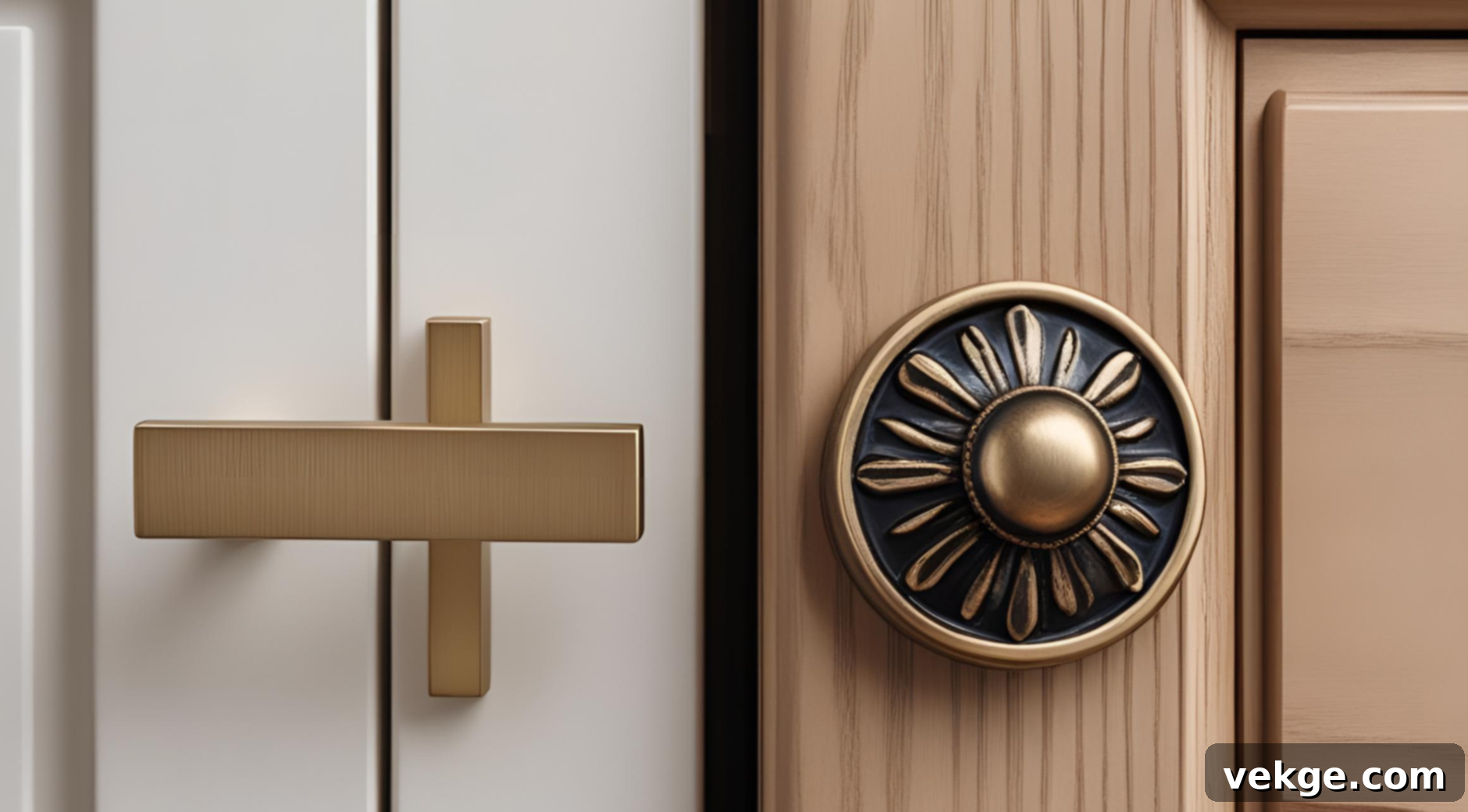
Envision contrasting hardware styles presented together. One image features sleek, minimalist bar handles or simple polished chrome knobs on Shaker cabinets, reflecting a contemporary sensibility. The other displays curved, oil-rubbed bronze pulls or intricate vintage-style knobs on traditional cabinets, underscoring their classic and decorative nature. This comparison powerfully illustrates how even small details like hardware can profoundly define the overall style and character of the cabinetry.
4. Finish and Color: Light vs Dark Tones
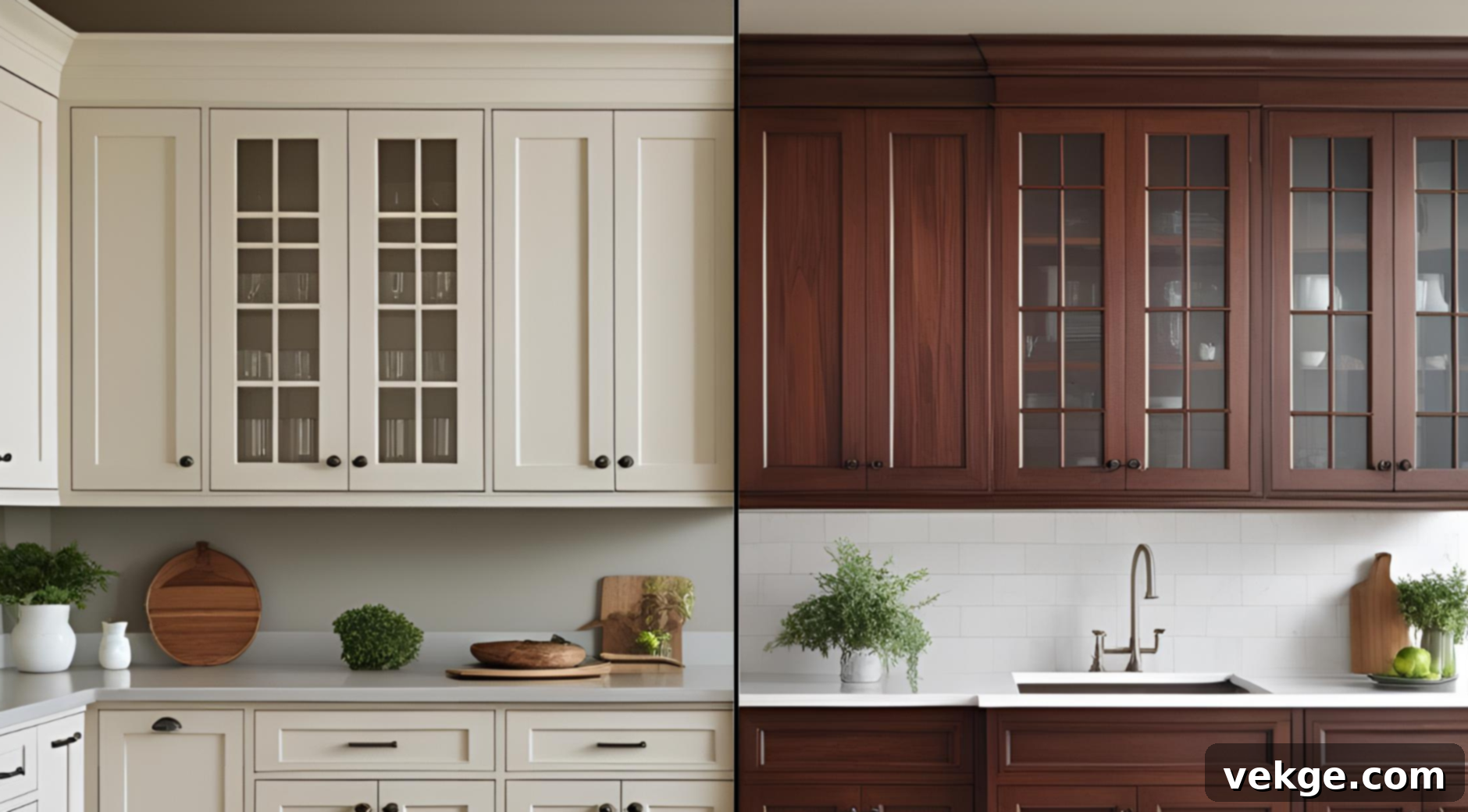
Visualize a bright, light matte finish – perhaps a crisp white or soft grey – on Shaker cabinets, enhancing their clean profile and contributing to an airy feel. Beside it, imagine a deep, rich wood stain, like cherry or mahogany, on traditional cabinetry, bringing out the wood grain and intricate details, creating a sense of warmth and luxury. This side-by-side view vividly demonstrates how different finishes and color palettes impact the mood and perceived formality of the kitchen space.
5. Kitchen Islands: Clean vs Carved Base Design
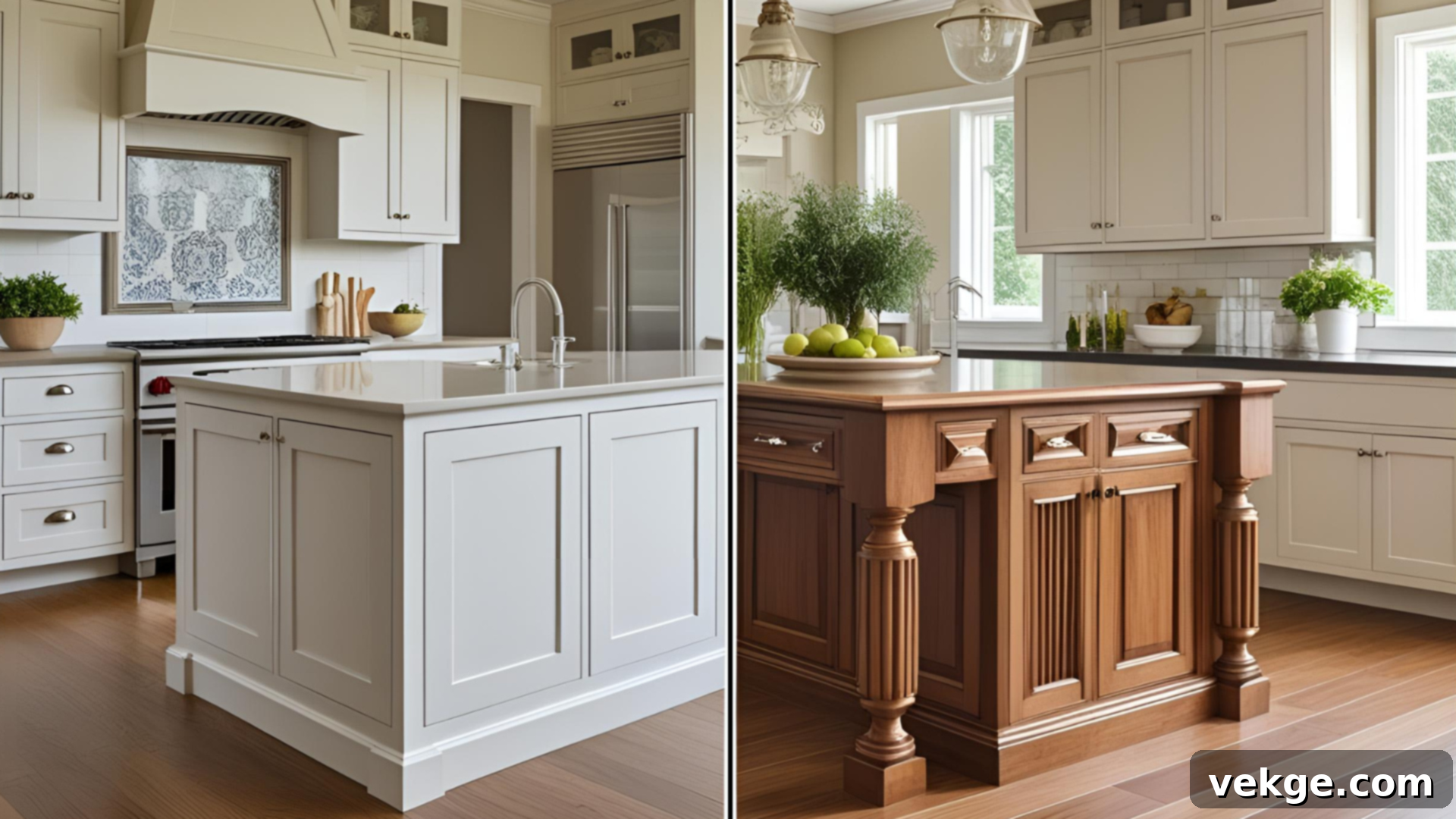
Compare two kitchen islands. One is a flat-paneled Shaker island, perhaps with a simple waterfall countertop and clean edges, emphasizing functionality and modern appeal. The other is a traditional island that incorporates decorative legs, elegant curves, fluting, or intricate base moldings, transforming it into a luxurious focal point. This contrast highlights how each style approaches the design of prominent kitchen elements.
6. Interior Storage: Sleek vs Fixed Layouts
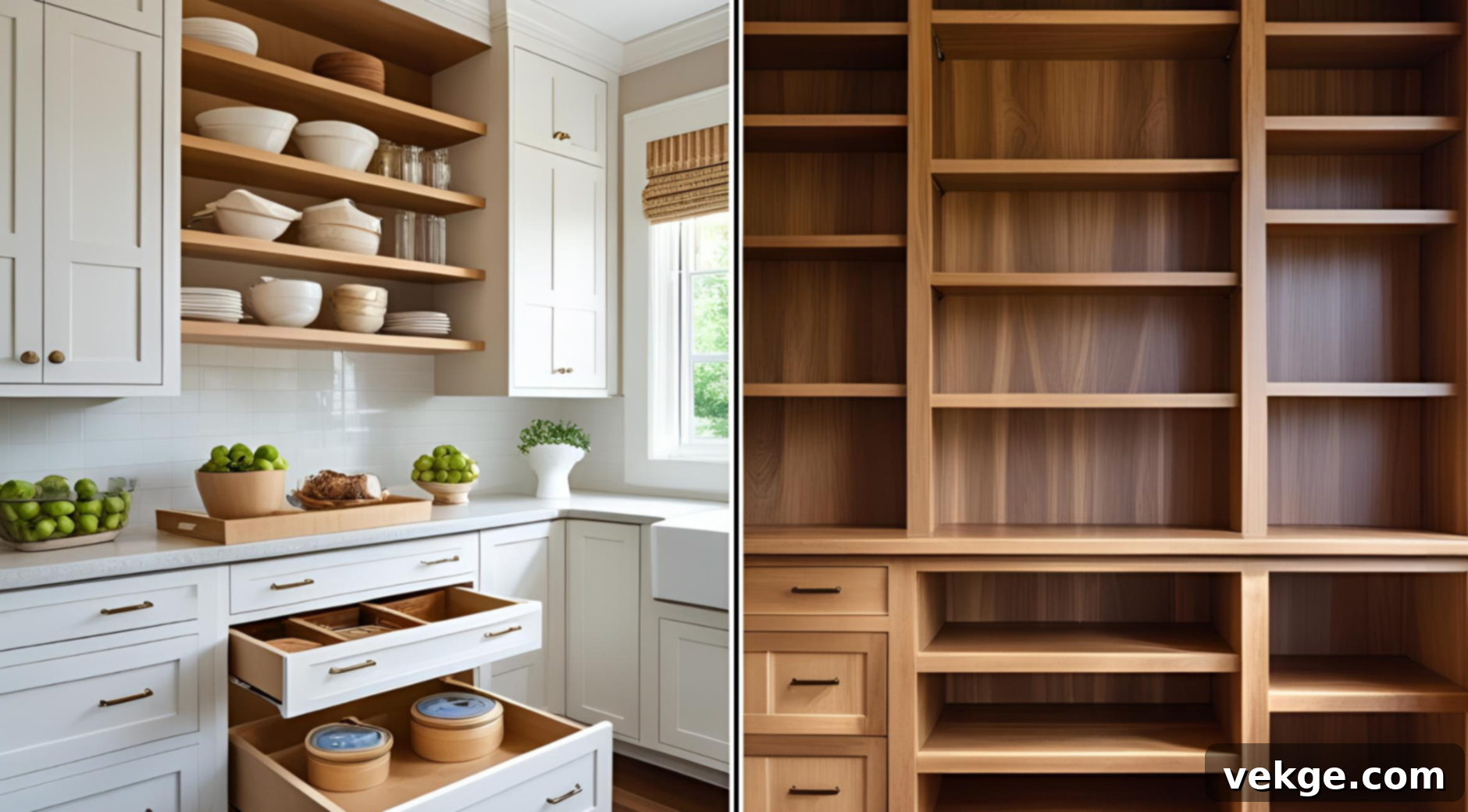
This comparison focuses on functionality and internal design. Imagine the interior of a Shaker cabinet revealing modern, sleek pull-out drawers, integrated organizers, and perhaps soft-close mechanisms, prioritizing seamless efficiency. Then, picture the inside of a traditional cabinet featuring classic fixed wood shelving, possibly with plate racks or glass-front displays, showcasing a more timeless, built-in structure. This pairing can help users compare contemporary convenience versus classic, robust internal organization.
7. Backsplash Pairing: Minimal Tile vs Patterned Design
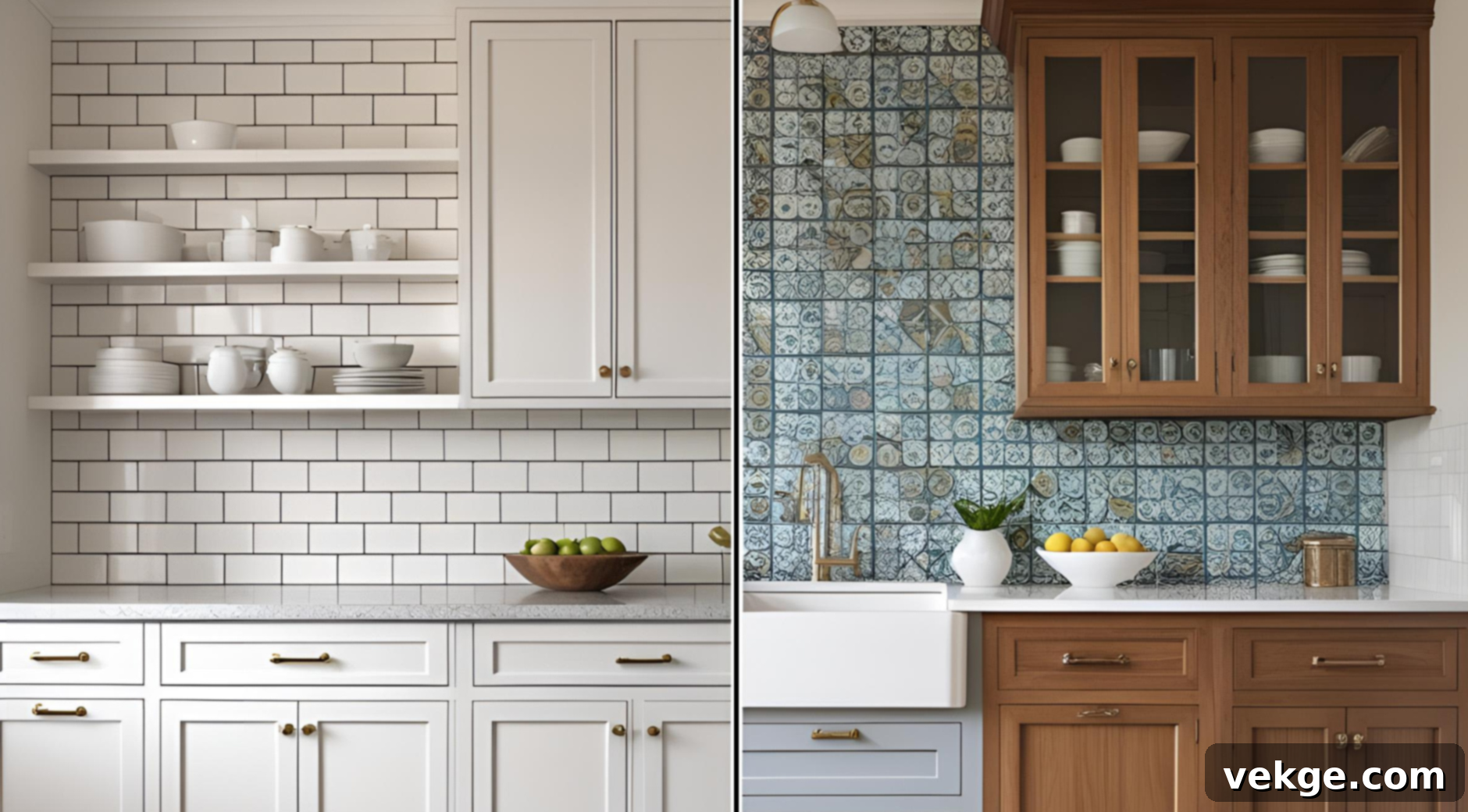
Visualize a simple, clean subway tile or a solid slab backsplash elegantly set behind Shaker cabinets, reinforcing their minimalist aesthetic. Adjacent to this, imagine a more intricate mosaic, a decorative patterned tile, or even a hand-painted mural tile behind traditional cabinets, enhancing their decorative richness. This comparison clearly illustrates how each cabinet style naturally aligns with different backsplash choices, impacting the kitchen’s overall visual texture.
8. Flooring Match: Light vs Rich Tones
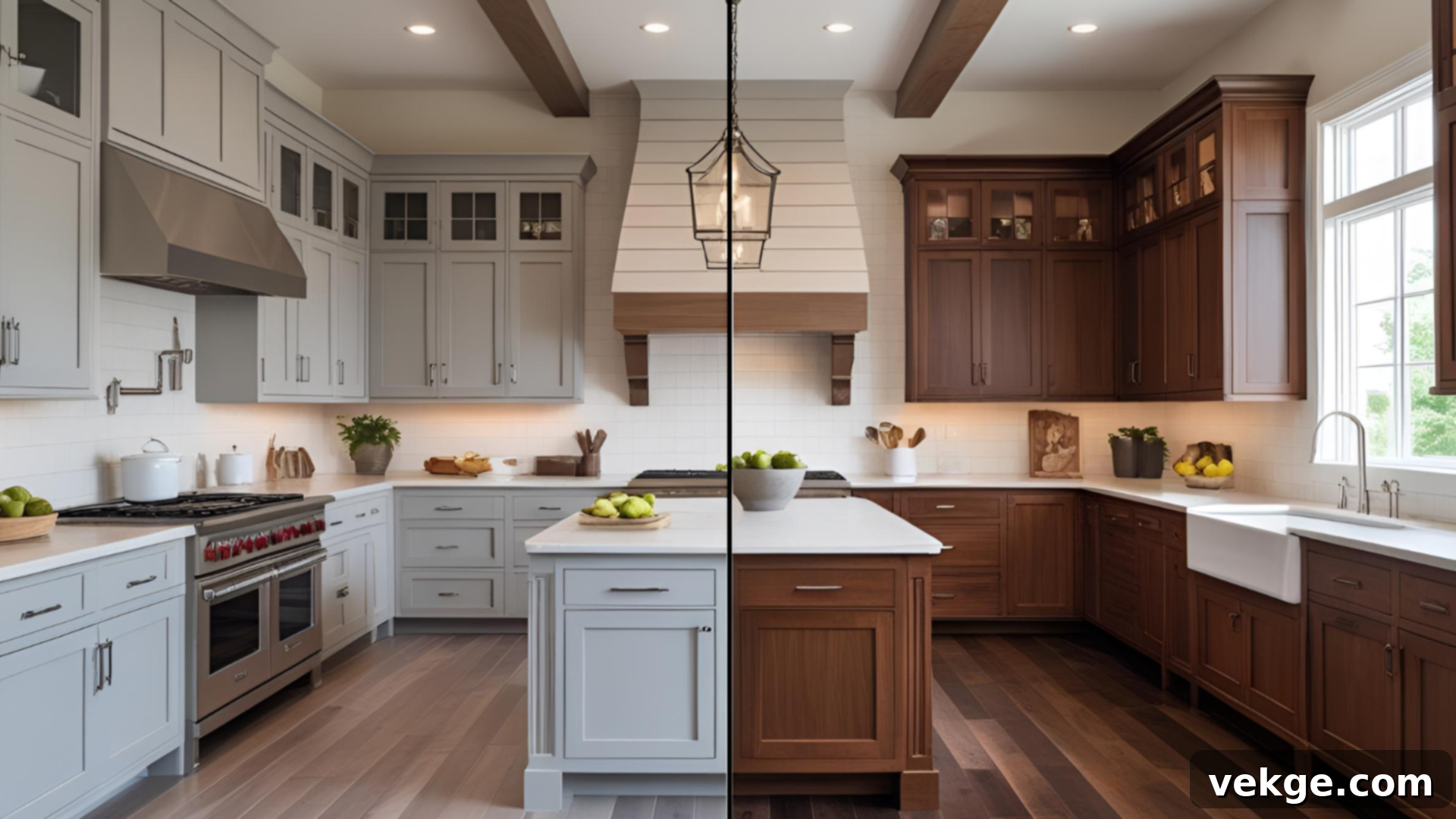
This visual depicts how flooring influences the overall harmony of the kitchen. Picture Shaker cabinets paired with light wood flooring, large format gray tiles, or polished concrete, contributing to a spacious and modern feel. In contrast, imagine traditional cabinets complementing dark stained hardwood floors, elaborate parquet, or classic marble tiles, which add depth and formality to the space. This comparison helps users understand how flooring choices can significantly complement or contrast with each cabinet style.
9. Appliance Integration: Seamless vs Statement Pieces

Consider how appliances are integrated into each style. One image shows Shaker cabinets with flush-mount, panel-ready stainless steel appliances, creating a streamlined, almost invisible integration. The other displays traditional cabinets alongside standalone, often more decorative or panel-covered appliances that are designed to be statement pieces, such as a professional-style range or a vintage-inspired refrigerator. This illustrates how cabinet style influences the selection and integration of kitchen appliances, impacting both aesthetics and functionality.
Quick Comparison Table of Shaker Cabinets vs. Traditional
To provide a clear and concise summary, here’s a quick comparison of Shaker and Traditional cabinets across several key factors, including their core design, typical pricing, required maintenance effort, and potential impact on your home’s resale value.
|
Feature |
Shaker Cabinets |
Traditional Cabinets |
|
Design |
Characterized by clean lines, flat recessed panels, and a simple, utilitarian form. Minimal ornamentation. |
Features raised panels, decorative trim, intricate carvings, and detailed finishes. Richly ornamented. |
|
Cost |
Generally more affordable due to simpler construction and fewer custom details and labor. |
Often higher in cost due to complex craftsmanship, intricate details, and specialized finishes and labor. |
|
Cleaning |
Easy to clean; smooth, flat surfaces and minimal grooves simplify maintenance. |
Requires more effort; intricate moldings, carvings, and crevices trap dust and grime. |
|
Versatility |
Highly versatile; adapts well to modern, transitional, farmhouse, and minimalist styles. |
Best suited for classic, formal, European, Victorian, or historically-inspired interiors. |
|
Resale Value |
Widely appealing to a broad range of buyers, especially those looking for modern or classic aesthetics. |
Adds significant beauty and character in classic homes; may feel too specific or dated in modern layouts for some buyers. |
Conclusion: Making Your Confident Choice
Choosing between Shaker and Traditional cabinets for your kitchen remodel doesn’t have to be a source of stress or indecision. By thoughtfully considering your home’s existing architectural style, your daily lifestyle needs, your personal aesthetic preferences, and your budget, you can confidently pinpoint the style that will best serve you and enhance your living space.
Remember, both Shaker and Traditional options represent enduring quality and timeless appeal. There isn’t a “wrong” choice, only a different one that aligns with your specific vision. Whether you lean towards the clean, adaptable lines of Shaker or the rich, detailed elegance of Traditional, each style offers distinct advantages that can transform your kitchen into a dream space.
If you decide to blend the two styles, as is popular in transitional designs, remember that consistency in finishes, a harmonious color palette, and thoughtful hardware pairings will ensure a cohesive and sophisticated result. We hope this comprehensive side-by-side comparison has provided you with valuable insights and given you the clarity you need to move forward with your kitchen renovation plans.
As you embark on your kitchen update journey, feel free to browse my other guides on various cabinetry styles, practical layout planning strategies, and diverse finish options. They are meticulously designed to empower you with knowledge, helping you make confident, informed choices every step of the way to create a kitchen you’ll love for years to come.
